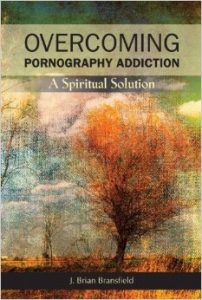Overcoming Pornography Addiction: A Spiritual Solution
by Monsignor J. Brian Bransfield
 Society is gradually coming to grips with the reality that viewing pornography is not just a benign practice, nor is opposition to it simply a moral hang-up of conservative Christians; rather, using pornography is a dangerous activity that deeply affects its users and their loved ones. Even Hollywood is beginning to recognize this, as evidenced by the 2013 release of Don Jon, a movie starring Scarlett Johanssen and Joseph Gordon-Levitt which demonstrates how pornography inhibits a young man’s capacity to have a normal romantic relationship. Pornography promises quick access to sexual freedom, relief, and pleasure with few strings attached. But in reality users end up feeling empty and guilty, and can even become ensnared in a cycle of addiction.
Society is gradually coming to grips with the reality that viewing pornography is not just a benign practice, nor is opposition to it simply a moral hang-up of conservative Christians; rather, using pornography is a dangerous activity that deeply affects its users and their loved ones. Even Hollywood is beginning to recognize this, as evidenced by the 2013 release of Don Jon, a movie starring Scarlett Johanssen and Joseph Gordon-Levitt which demonstrates how pornography inhibits a young man’s capacity to have a normal romantic relationship. Pornography promises quick access to sexual freedom, relief, and pleasure with few strings attached. But in reality users end up feeling empty and guilty, and can even become ensnared in a cycle of addiction.
In Overcoming Pornography Addiction: a Spiritual Solution, Monsignor J. Brian Bransfield, the Associate General Secretary of the USCCB, sheds light on the nature and causes of Internet pornography addiction as well as the cultural developments that gave rise to this widespread phenomenon. He also lays out a path to forgiveness and healing for people struggling with addiction to pornography. Finally, he counters our culture’s warped perception of humanity reflected in the problem of pornography with the true vision of the human person as presented by St. John Paul II in his Theology of the Body. This concise, well-written book offers a lifeline to individuals, particularly men, struggling with pornography addiction. It is also a helpful guide to loved ones, counselors, spiritual advisors, and anyone interested in better understanding the roots of the addiction and the spiritual dimensions of healing.
The author begins by introducing Tom, who is caught up in pornography. Overwhelmed by the stress of his work and unhealed emotional wounds, Tom has turned to viewing pornographic websites. Rather than finding relief he becomes more and more bothered by his compulsive pornography use. One night Tom falls asleep at the computer after a long binge. His wife finds him there with the images still on the screen.
Tom’s situation is not a rarity. Due to its easy availability on the Internet, pornography addiction is a growing problem. No longer contained to the local Hustler or adult video store, pornography is now just a click away on any computer, smartphone, or tablet. The author writes that due to Internet pornography’s accessibility, affordability, and apparent anonymity, “even the most devoted family man and virtuous churchgoer runs a high risk and considerable vulnerability in sitting at the keyboard” (9).
The author explains that many begin viewing pornography as a means of escape (subconsciously or consciously) from the pain of various “wounds” in their lives. These wounds may have been inflicted by sexual trauma, neglect, rejection, divorce, or a loved one’s death. Pornography seems to offer instant gratification and relief.
The author further explains that it is easy to get caught in a four-step cycle of use. First, there is preoccupation to view caused by certain triggers (work stress, for example). Second, there is the decision to view, and the initiation of the “pre-viewing routine” (such as closing the door or darkening the shades). The high of pornography is similar to that of drugs. Once the routine has been initiated, natural painkillers such as endorphins are released by the body (29). Third, there is the viewing of pornography websites and the experience of a high. Finally, the thrill wears off and the user is often left feeling guilty and ashamed. The user desires relief from these feelings, as well as from the pain and stress of life that were not cured by viewing pornography, and the cycle begins anew. This cycle can have disastrous effects including personal instability, employment problems, damage to family life, and divorce.
So once a person like Tom is caught up in this cycle of addiction, where is he to turn for help? Msgr. Bransfield offers a clear answer: Jesus. The journey to healing must be founded on the cross of Jesus Christ.
The story of Jesus’ interaction with the woman of Samaria in John’s Gospel offers the first steps to healing. The author notes that Jesus encounters the woman at high noon. She is at the well alone in the heat of the day, rather than with the other women in the cool of the morning, because she has been ostracized from society on account of her sins. Jesus reaches out to her at this moment. He brings her sins to light (“you have had five husbands” [John 4:17]) and then reveals Himself as the Messiah. She is set free from her sin and runs into town to testify to Jesus, no longer afraid of the rejection of others, and many people convert because of her witness.
Jesus also wants to come to those struggling with pornography addiction “in the time of our intensity and embarrassment” and “to save us, to begin a new narrative in our life and to heal us” (15). Healing often begins at the moment of hitting bottom, when the fantasy of quick pleasure is shattered and the truth of addiction is made clear. In this moment one is able to emerge from denial, and to hope in God for a better life.
The author emphasizes that a person cannot overcome addiction on his own. He will need some combination of a wise spiritual advisor, a professional counselor, and a support group. But the work of inner healing is ultimately his own and this must be founded on the sacraments, particularly Reconciliation and the Eucharist. Through the sacraments God communicates forgiveness and strength to help a person develop virtue and ultimately conquer the addiction.
The book concludes with a discussion of our culture’s understanding of happiness—to acquire pleasure quickly—in large part a product of the industrial, sexual, and digital revolutions. It then offers the vision of happiness as presented in the Theology of the Body of Saint John Paul II—to give beauty slowly through the gift of self—as both a source of personal healing and the cultural foundation necessary to transform society into a “civilization of love.”
Overcoming Pornography Addiction offers a superb analysis of the insidious nature of pornography addiction and gives compassionate spiritual guidance to individuals seeking to overcome this problem. The author’s practical advice is sound not only for users of pornography, but for anyone struggling with any type of serious vice in their life.
It is worth noting that the example of Tom is actually a fictitious account and the details are a bit vague. The book does not include real-life stories. A true account of a person who has overcome addiction to pornography through the healing power of Jesus Christ may have helped readers more fully connect to the author’s powerful message.
That being said, this book is an excellent resource for individuals who are using Internet pornography, those who have a loved one struggling with addiction, and for counselors (both spiritual and secular) seeking to help users break the cycle of addiction. As Msgr. Bransfield says in his introduction, there are no “magical” solutions in life, but there are real, living solutions to life’s problems for those ready to respond to the call of Jesus Christ, who brings forgiveness and healing.
About the reviewer
Caitlin Dwyer is a freelance writer and editor as well as an adjunct professor at Thomas More College in Crestview Hills, KY . Caitlin holds a Masters in Theological Studies from the John Paul II Institute for Studies on Marriage and Family.
Disclaimer: Book reviews do not imply and are not to be used as official endorsement by the USCCB of the work or those associated with the work. Book reviews are solely intended as a resource regarding publications that might be of interest to For Your Marriage visitors.




